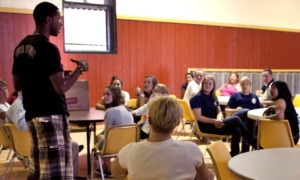
Blue Planet Studio/Shutterstock
.
As the population of homeless in America, including the population of homeless youth, continues to grow, it is vital that programs and providers aim their efforts at the real needs of homeless youth and avoid a “one size fits all” approach. The issues driving youth homelessness, their specific needs and the specific way homeless youth tend to use services require that homeless youth be seen not as a subpopulation but a distinct population that is best served by attending to the complexity of factors driving youth homelessness.

Jed Metzger
There are a host of factors that have been found to drive homelessness in youth, as Adrienne Fernandes-Alcantara noted in her congressional report. Before unpacking the leading drivers, it is vital to caution providers to reject descriptions of homeless youth as “victims” of harmful forces.
As professors Erin Toolis and Phillip Hammack importantly remind us in their 2015 paper, most homeless youth do not see themselves as victims, quite the opposite; they connect to their survival skills in the face of the external factors. Thus, one takeaway here is to meet homeless youth with a mindset that values their expertise.
That said, youth become homeless in large numbers because home was not seen as a safe place for them. They describe the forces that create this lack of safety as related to abuse, neglect, domestic violence, adult substance abuse, poverty, adult relational instability and related factors. The literature often uses terms such as “runaway” or “throwaway” as descriptors. While I don’t favor using these terms, they do underscore the point that many homeless youth have become homeless because they feel it is better for them than where they were.
Special mention needs to be made of two subpopulations; youth escaping the foster care system and LGBTQ youth. The literature, which is extensive regarding these two groups, underscores the critical nature of homeless youth service providers to be able to value the lived reality of the youth. More important than the factors driving homelessness in youth is how to deliver quality programming that meets their real and expressed needs.
Before diving into the specifics of any approach it is vital to note that how we are with the youth may be more important than what we do. This, takeaway number two, is about the importance of sticking with the youth, of not expecting them to smoothly transition into some type of full adult-like functioning because we offered them a service.
What they need from providers
As providers of services we need to be patient. We need to build safe relationships in which we deeply listen to the youth and don’t get ahead of them. This is predicated on believing that youth actually know what is good for them. In my 36 years of working with youth, nothing is as true as the expression that “youth vote with their feet.” If youth have decided that they were not safe where they were, then it is incumbent on us to listen to them so they feel safe around us. Experience has shown that one important service approach is to create services that are specifically for homeless youth.
Building on the recommendation that services be specific to homeless youth, a range of services should be offered, all with a strong relational component. Across the homeless literature the “housing first” model has been clearly shown to be a best practice; this has also been found to be true for homeless youth.
The caveat is that housing first is a model that finds permanent housing and supports youth addressing their challenges once in housing, but this housing needs to be permanent as opposed to a shelter. While shelter has value, it is not a preferred service by the youth. In fact, this study found youth preferred a quality drop-in center over shelter.
Quality in this case reflects service providers who are willing to meet youth where they are both emotionally and physically. This means we need to be comfortable with going out and visiting the youth where they physically are. In addition, youth want us to safely connect to them. Handing a kid a pamphlet does not reach that level. In truth, a meal is worth a stack of pamphlets. Homeless youth have needs but they are wary service consumers. It is our job to approach youth by valuing their skills and not getting ahead of them.
This is of course tricky for law enforcement, who face homeless youth with multiple mandates. What I have directly observed is that those law enforcement officers who develop relationships first by talking with the youth before directing the youth end up being superuseful in helping those youth get their basic safety needs met.
Any review of the literature will discuss the high rates of substance use, mental health, education and sexual health challenges of homeless youth. Take away number three is that the youth know this: They do not need us to tell them that drugs are bad, psychotropic medication compliance is important, degrees mean better jobs, condoms are good and so forth.
What they need is safety, to be valued and people who will hang in there with them as they do the best they can. As such, services that are designed with acceptance and forgiveness have a better chance of engaging the youth and thereby meeting their real needs.
Jed Metzger, Ph.D., LCSW-R, is a professor of social work at Nazareth College. For the past 12 years he has been one of the lead organizers of Project Homeless Connect Rochester and has a 36-year history providing a variety of social work services to youth facing a variety of vulnerabilities.































